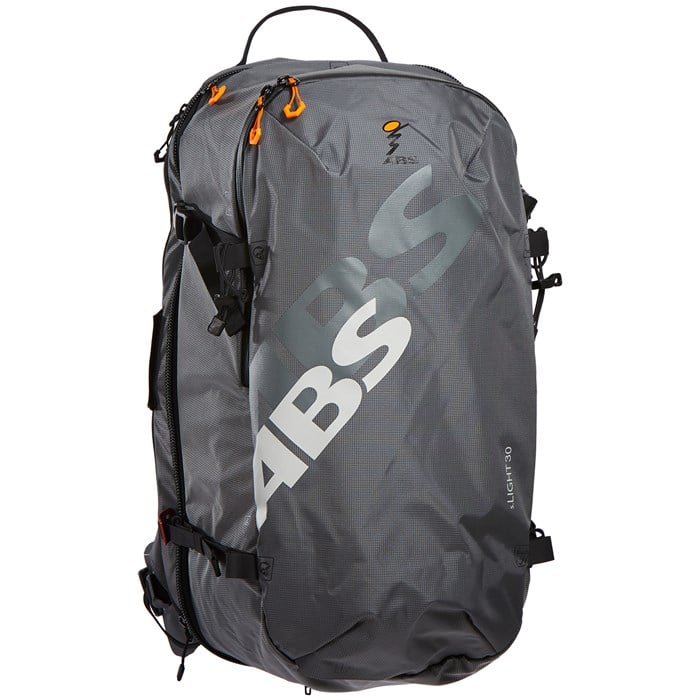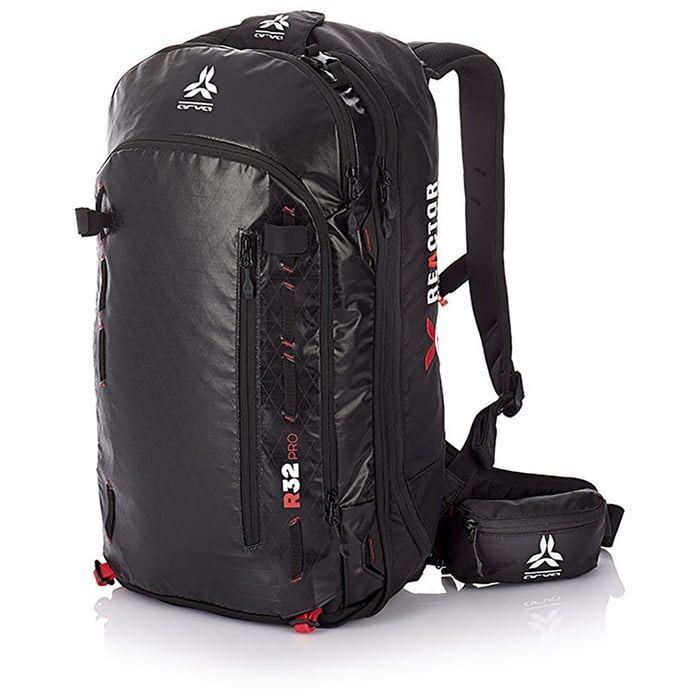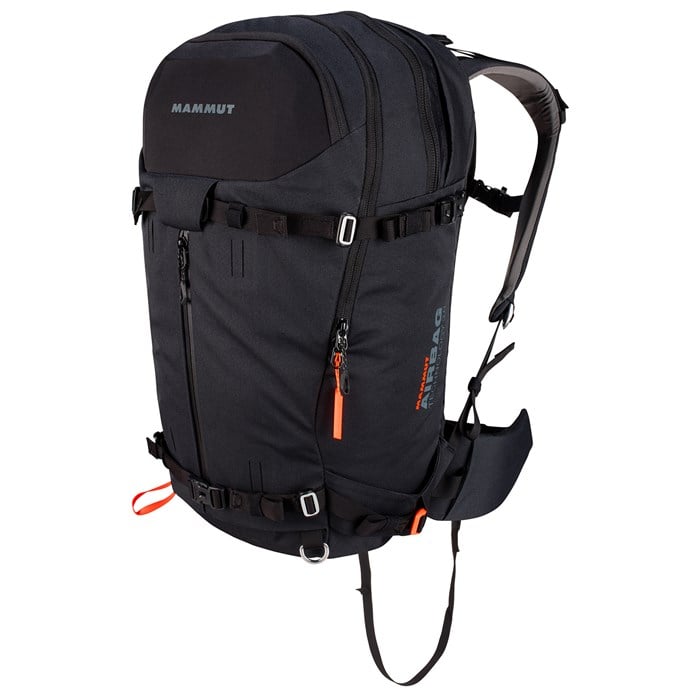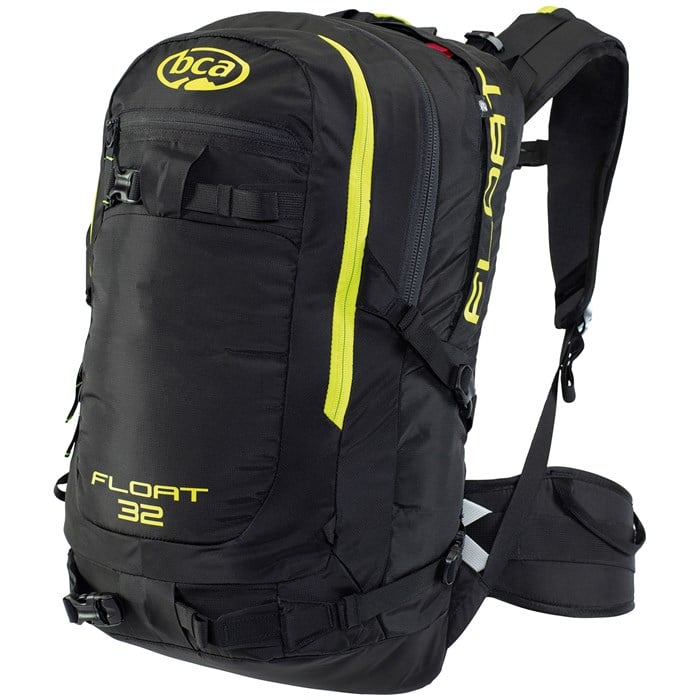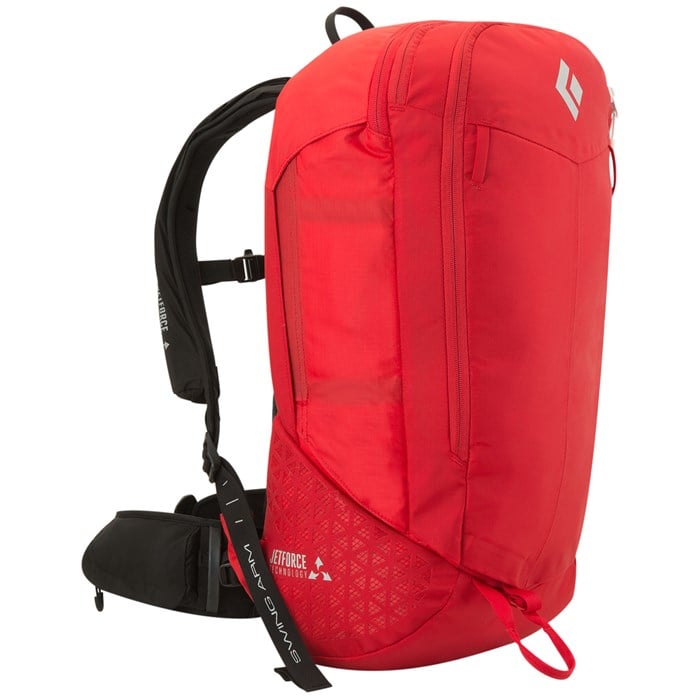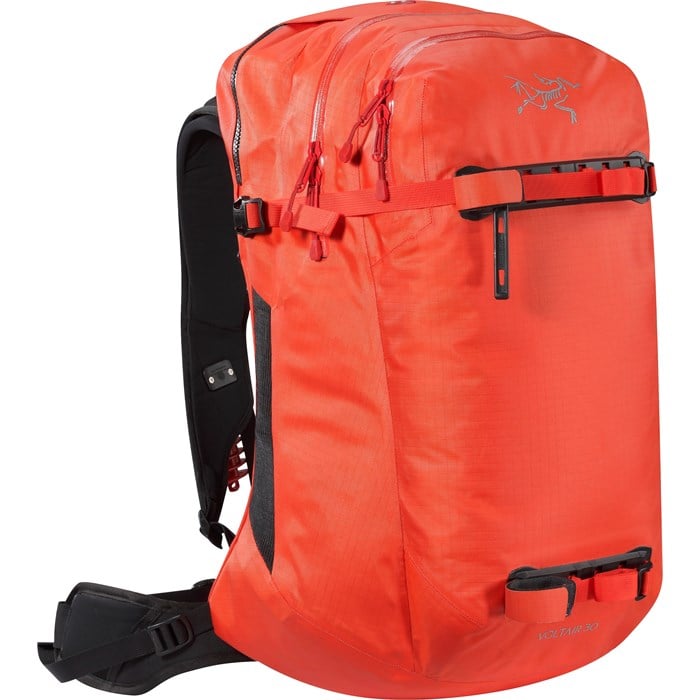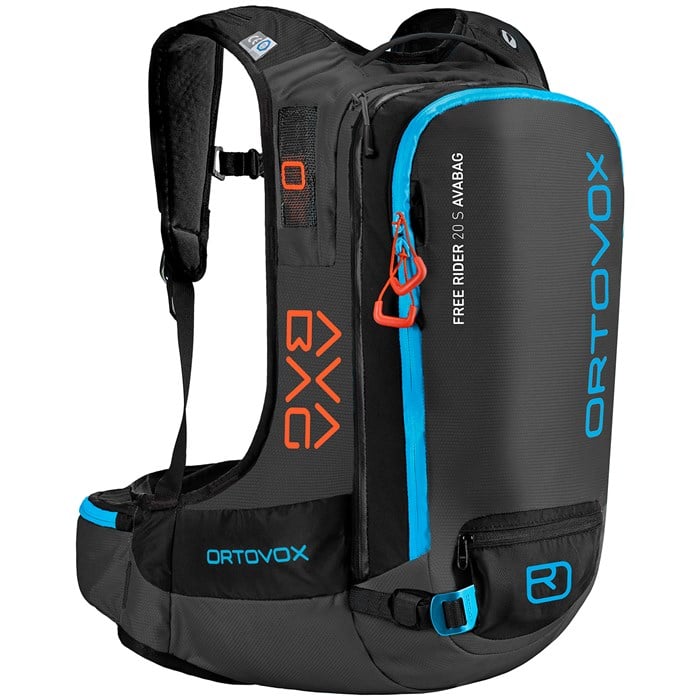How to Choose an Avalanche Airbag Pack
Avalanche airbag packs are quickly becoming the fourth piece of must-have safety gear for backcountry travelers, alongside your beacon, shovel, and probe. If you are wearing an airback pack when caught in a slide, you pull a handle attached to the shoulder strap and a pressurized cartridge or electric fan inflates the airbag, which helps to keep you near the surface of the avalanche and more visible to rescuers.
How Do Avalanche Airbags Work?
When properly worn and deployed, avalanche airbag backpacks have been shown to be effective in increasing your chances of survival if you are caught in an avalanche. Ski and snowboard airbags work on the principle of “Inverse Segregation,” sometimes known as the Brazil Nut Effect. This principle holds that in a moving aggregate of objects large and small (like an avalanche), the larger objects will rise to the top. You can demonstrate this with a bowl of unshelled mixed nuts by shaking it – the larger Brazil nuts will tend to rise to the top, while smaller varieties will sink to the bottom. Deploying an avalanche airbag during a slide effectively turns you into a larger object and greatly increases the chance of you ending up on top of the debris pile when the avalanche stops moving.
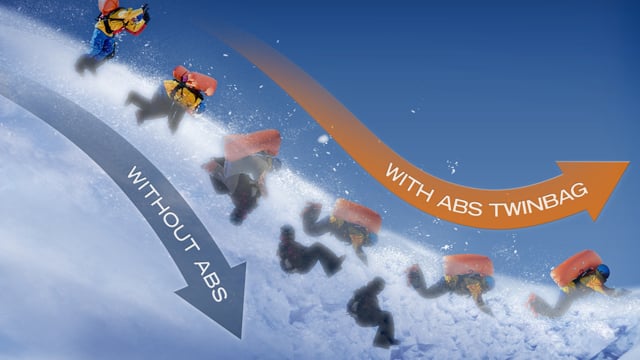
Keep in mind that wearing an avalanche airbag is no guarantee of survival and the first thing to remember is to make smart decisions so you avoid the avalanche in the first place. That said, your chances of coming to rest near the surface after an avalanche and being found faster are greatly enhanced by using an airbag pack.
There are a number of companies involved in the manufacturing of avalanche airbag packs. Each company offers differences in design, versatility, and price, which we’ll try to summarize in this article.
Some Things You Should Consider When Choosing an Avalanche Airbag Pack
- What type of riding will you be doing when you use this pack? Side country lines call for a smaller, more streamlined pack than multi-day hut touring, for example.
- Do you need an airline compliant bag? Different airlines have different rules and regulations regarding traveling with airbag packs and cartridges, so be sure to check with your airline before you fly. Fan powered bags can make travel easier, as you avoid the possible need to travel with an empty cartridge and refill or replace it upon arrival. The availability of filled cartridges and qualified refilling stations also varies by location.
- Do you want the potential to transfer the airbag and inflation mechanism from one pack to another? Some makes and models offer this option, which makes it possible to use the same airbag interior features with multiple sizes and styles of packs.
- Does the pack fit your torso length and body type? Some models are available in more than one length.
- What is your budget? Avalanche airbag packs come in a wide variety of price points.
- Will the ski or snowboard carry system for this pack work for you? Some avalanche airbag packs limit the ways you can attach items without blocking the airbag apparatus.
- Is the pack comfortable when weighted for your typical use? Regardless of airbag functionality, you still want a pack that's comfortable to hike and ride in.
Types of Avalanche Airbag Activation Systems
The biggest difference you'll find between avalanche airbags is the method by which they deploy. The most common is to use a canister of compressed gas to rapidly fill the bag, but some newer models use a powerful battery powered fan. We'll break down the pros and cons of each option here.
Canister / Cartridge Airbags
The canister or cartridge is a metal or carbon fiber cylinder that holds highly pressurized gas, which is used to inflate the airbag. Canister airbags are powerful and reliable, with the main drawback being that the canister only has one use in it before needing to be refilled or replaced, which can be prohibitive to extensive practice. Also, you will probably have to jump through a few extra hoops at the airport if you plan on traveling with one. At present, many brands offer user-refillable canisters that can be filled with compressed air at certain shops, while some brands canisters are not user-refillable, and must be returned to a dealer to be refilled.Electric Fan Airbag Packs
New airbag packs from Black Diamond (JetForce) and Arc'teryx (Voltair) use battery operated fan systems to inflate the airbag and eliminate the need for cartridges. The airbag is inflated by a high speed fan, and can be deployed multiple times on a single charge. This system makes air travel with your airbag much easier and gives you the ability to practice inflation of your airbag at home or on snow knowing you have more than one activation per battery charge.
How to Choose the Right Size Avalanche Airbag
Volume
Start by determining where you’ll be using this airbag pack and what sort of riding you’ll be doing with it. If you plan on doing mostly lift-served backcountry with an occasional heli or cat trip, and only need to carry a bit of food and water plus maybe a thin puffy coat, an 18 to 20 liter pack, or even smaller, may be perfectly adequate. Day touring typically requires a pack with a capacity of between 25 and 35 liters. For longer trips, or multi-day hut touring, look for something in the neighborhood of 40 to 50 liters. Keep in mind that not all manufacturers calculate their pack volumes in the same way, and the airbag canister and mechanism takes up space.
Many manufacturers offer the option of swapping the airbag and its mechanism between multiple packs – this allows you to choose the size that is most appropriate for each trip without buying an entirely new pack with a second airbag mechanism (it’s the expensive part). Mammut, ARVA and Ortovox allow the user to swap the airbag mechanism between their own compatible packs or simply remove them when avalanche danger is minimal. Similarly, BCA lets you move the airbag and internals of its Float™ Series packs between its 22 liter and 32 liter models, as well as several K2-branded models with different volumes.
Fit
As with any pack, it’s important to try an avalanche airbag pack on to make sure it fits. Not all manufacturers offer a choice of torso lengths, so if you are very tall or very short, you may find it necessary to look at a certain make or volume of pack. Load the pack with roughly the weight you intend to carry and see how the straps, back and hip belt feel. Avalanche airbag packs have a harness strap that fastens between your legs to ensure that the pack doesn’t get torn off your body in a slide – make sure you fasten this when you try it on as well.
Airbag devices place some restrictions on how you carry your skis or snowboard, since you won’t want to block the path of the inflating airbag while traveling in avalanche terrain. Make sure you understand the carry options for the pack you’re interested in and are okay with how they will work with your skis or board. Think through the process of wearing and using the pack from start to finish. As with a ski or binding system, you are the one who’ll be wearing and using it and your preferences are important.
The differences between brands and models may be significant and don’t necessarily relate to price. For instance, the dual airbag ABS® TwinBag system could be considered an advantage, but so could the Mammut/Snowpulse® wrap-around Protection Airbag.
Major Airbag Manufacturers and Their Systems
ABS®
ABS® has the longest history of development and success in the avalanche airbag business, and has kept the most complete set of survival statistics. It's systems offer a two bag TwinBag system for inflation redundancy in case one bag is punctured, and the activation handle uses a small explosive charge to drive the needle that punctures the compressed gas cartridge. Used cartridges may be recycled, but can only be refilled by ABS® and should be exchanged at an ABS® dealer. ABS® offers both “built-in” ABS® Inside systems and its swappable Vario system, which allows you to zip different packs onto a Vario base unit. The list of ABS® partner companies includes The North Face, Quiksilver, Mountain Hardwear and Salomon.
ARVA
ARVA is a well known French producer of packs and avalanche gear who have gotten into the airbag market with a well-designed and minimalist line of packs called "REACTOR." REACTOR airbags packs use a dual chamber airbag and lightweight compressed air or argon cartridges that can be refilled at certified shops. The airbag mechanism can be transferred between various packs with volumes between 18 and 40 liters, and the designs are among the lightest and most compact on the market.
Mammut
Mammut, the venerable Swiss clothing and mountaineering manufacturer, offers two styles of airbag packs. The “Protection” style wraps around the head and upper torso of the wearer, providing additional head, neck and upper body protection. The R.A.S. 3.0 (Removable Airbag System) is a single bag system that also extends to the torso. Both styles can be swapped between compatible packs of varying volumes. The Mammut cartridge is user-refillable at scuba and paintball shops with the correct adapter. Dakine offers a series of Poacher R.A.S. 3.0 packs in volumes of 26, 36 and 46 liters.
BCA
Backcountry Access (BCA), recently purchased by K2, offers the Float™ avalanche airbag packs in a variety of volumes. Float™ compressed air cylinders are user-refillable at scuba and paintball shops using the proper adapter. The latest versions of the Float™ Series packs are well thought out and the pricing is super competitive.
Black Diamond
Black Diamond's JetForce packs use a battery-operated high speed fan to inflate the airbag, eliminating the need for cartridges. The airbag can be deployed as many as 4 times before requiring a recharge, and eliminates the common air travel issues of cartridge style packs. Black Diamond and their subsidiary PIEPS offer a number of JetForce pack options between 11 and 40 liters.
Arc'teryx
Arc'teryx has entered the airbag pack market with their battery powered Voltair packs in 20 liter and 30 liter sizes. As with the Black Diamond system, it is possible to deploy the airbag mulitiple times on a single charge, and the electric system solves many of the issues inherent in travelling with a cannister-based airbag. Battery powered systems, though more expensive, arguably remove an element of hesitation in deploying the bag in "maybe" situations, and allow for unlimited practice sessions with a minimum of hassle.
Ortovox
Ortovox, out of Germany, was orgnially formed in the 80's with the first double frequency transceiver. So when they introduced the Avabag Avalanch Airbag Backpack system in 2016, it was undoubtedly going to be a true contender. Known for ultralight and well-fitting packs, Ortovox has become one for exceptional reliability. Offered in a wide variety of sizes from 18L to 40L with a compressed air cartridge that can be refilled at most scuba and paintball shops and the shops listed here.
How to Fly with an Avalanche Airbag
First off, yes, you can fly domestic or international with an avalanche airbag. However, it can be tricky, so make sure you know the specific rules for your system and your destination before you take off. It all comes down to where you will be traveling (domestic vs international) and what system you possess. Flying with your Electric Fan Pack should not be a problem. Electric Fan Packs do not contain compressed gas or explosives and are considered a consumer electronic device when the battery is installed in the backpack. If you plan to do a lot of air travel with your pack, electronic airbags take the cake for ease of transport.
On the other hand, you CAN fly with Canister/Cartridge Activation System Airbags but, it can easily become a headache and varies with the airline you are flying with and the officials you interact with. Compressed Air Cylinders are considered hazardous goods by the International Air Transport Association (IATA) but in the case of “Avalanche Rescue Backpacks” underlies an exception.
“A single (1) avalanche rescue backpack per person is authorized containing a cylinder of compressed gas in Division 2.2. They may also contain an explosive trigger mechanism containing less than 200 mg net of explosives in Division 1.4S.”
TSA requires travelers on flights originating in the United States to demonstrate that gas cartridges are empty and not connected to the airbag. You will have to either fill up your cartridge after touching down or buy/rent a new filled cartridge at your destination in order to use your airbag pack. If you have a refillable model, it is a good idea to travel with the extra gaskets, grease and seals you will need for the refill. Once empty, it is important to separate the head from the cylinder as its TSA’s job to verify there are no explosives inside. It is also wise to be diligent about storing the parts in their own contained baggie, as contaminated parts like the threads or O-ring on the cylinder or head can lead to problems holding air. We recommend you carry your Avalanche Airbag on the plane with you, giving you the chance to deal with any problems face to face and dismissing the potential for a heartbreaking surprise at baggage claim.
When traveling internationally it is important to be flexible. Not all US flying regulations are true elsewhere. Verify by calling the international airline you plan on flying and request more detailed information. There are other ways to go about traveling with your airbag backpack WITHOUT bringing the cylinder. For example, if traveling to Japan, there are shops and dealers that likely sell or rent canisters, depending on the brand. Airbag Backpack manufactures are more than happy to help in answering your questions when it comes to traveling/purchasing or renting canisters overseas.
Other Considerations
Pull Handle Configuration
 Some people consider the bell-shaped pull handle on the BCA Float™ packs to be easier to grab from any angle, while some people are fine with a T-handle. You’ll have to make up your mind on your own, but do some research and look at the options first. Also think about whether you’re more comfortable pulling the cord with your right or left hand. Some models offer the option of switching sides, others do not. Right-handed people and most skiers and snowboarders prefer to pull with their right hand; snowmobilers (a huge market for airbag packs) usually prefer to pull with their left hand so they can keep their right hand on the throttle.
Some people consider the bell-shaped pull handle on the BCA Float™ packs to be easier to grab from any angle, while some people are fine with a T-handle. You’ll have to make up your mind on your own, but do some research and look at the options first. Also think about whether you’re more comfortable pulling the cord with your right or left hand. Some models offer the option of switching sides, others do not. Right-handed people and most skiers and snowboarders prefer to pull with their right hand; snowmobilers (a huge market for airbag packs) usually prefer to pull with their left hand so they can keep their right hand on the throttle.
Testing and Maintenance
All manufacturers recommend periodic inspection of the airbag and trigger mechanism, as well as annual test deployment. Inspect your airbag and handle for signs of wear or weak spots after any deployment. Test your airbag to see that everything works before the start of each season (this is a huge crowd pleaser in ski town bars) and have the entire system inspected as the manufacturer recommends. Good luck in your search for an avalanche airbag pack, and may you shred safely and happily without ever needing to use it.
*Wearing an avalanche airbag pack is not a guarantee of survival if you are caught in an avalanche. The best way to avoid death or injury by avalanche burial is to avoid being caught in the first place.
We recommend that backcountry travelers take an AIARE Level One class or equivalent and practice the skills they learn there regularly with their partners. Here are some great resources for avalanche safety education:
— American Institute for Avalanche Research and Education
— American Avalanche Association
— Northwest Weather and Avalanche Center
— Avalanche Canada
You should carry an avalanche beacon, shovel and probe when travelling in avalanche terrain and know how to use them. Backcountry travel requires an acceptance of the risks involved (avalanches are not the only danger) and implies a willingness to take responsibility for educating oneself about these dangers and ways to mitigate them.
Learn More With Our Other Backcountry Guides:
Backcountry Basics - How to Get Started
Splitboarding - How to Get Started
How to Skin for Backcountry Travel
How to Trim or Cut Climbing Skins
Backcountry Gear Checklist
How to Choose Alpine Touring Skis
How to Choose Alpine Touring Ski Boots
How to Choose Alpine Touring Bindings
Getting Started with Dynafit (Tech) Bindings
How to Choose Climbing Skins
Climbing Skins Size Guide
Climbing Skins Weight Chart
How to Dress for Backcountry Skiing & Snowboarding
This is evo. We are a ski, snowboard, wake, skate, bike, surf, camp, and clothing online retailer with physical stores in Seattle, Portland, Denver, Salt Lake City, Whistler, and Snoqualmie Pass. Our goal is to provide you with great information to make both your purchase and upkeep easy.
evo also likes to travel to remote places across the globe in search of world-class powder turns, epic waves, or legendary mountain biking locations through evoTrip Adventure Travel Trips. Or, if you prefer to travel on your own, check out our ski & snowboard resort travel guides and mountain bike trail guides.
Still have questions? Please call our customer care team at 1.866.386.1590 during Customer Care Hours. They can help you find the right setup to fit your needs.
